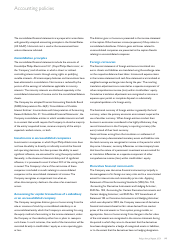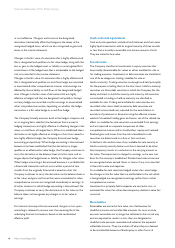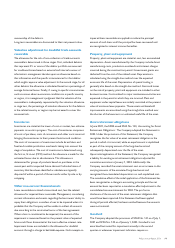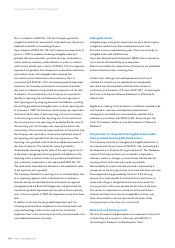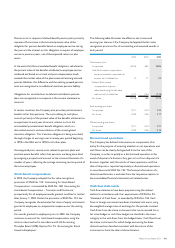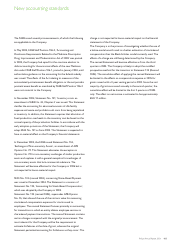Philips 2004 Annual Report Download - page 98
Download and view the complete annual report
Please find page 98 of the 2004 Philips annual report below. You can navigate through the pages in the report by either clicking on the pages listed below, or by using the keyword search tool below to find specific information within the annual report.The consolidated financial statements are prepared in accordance
with generally accepted accounting principles in the United States
(US GAAP). Historical cost is used as the measurement basis
unless otherwise indicated.
Consolidation principles
The consolidated financial statements include the accounts of
Koninklijke Philips Electronics N.V. (‘Royal Philips Electronics’, or
the ‘Company’) and all entities in which a direct or indirect
controlling interest exists through voting rights or qualifying
variable interests. All intercompany balances and transactions have
been eliminated in consolidation. Net income is reduced by the
portion of the earnings of subsidiaries applicable to minority
interests. The minority interests are disclosed separately in the
consolidated statements of income and in the consolidated balance
sheets.
The Company has adopted Financial Accounting Standards Board
(FASB) Interpretation No. 46(R) ‘Consolidation of Variable
Interest Entities’. In accordance with Interpretation of Accounting
Research Bulletin No. 51 ‘Consolidated Financial Statements’, the
Company consolidates entities in which variable interests are held
to an extent that would require the Company to absorb a majority
of the entity’s expected losses, receive a majority of the entity’s
expected residual returns, or both.
Investments in unconsolidated companies
Investments in companies in which Royal Philips Electronics does
not have the ability to directly or indirectly control the financial
and operating decisions, but does possess the ability to exert
significant influence, are accounted for using the equity method.
Generally, in the absence of demonstrable proof of significant
influence, it is presumed to exist if at least 20% of the voting stock
is owned. The Company’s share of the net income of these
companies is included in results relating to unconsolidated
companies in the consolidated statements of income. The
Company recognizes an impairment loss when an
other-than-temporary decline in the value of an investment
occurs.
Accounting for capital transactions of a subsidiary
or an unconsolidated company
The Company recognizes dilution gains or losses arising from the
sale or issuance of stock by a consolidated subsidiary or an
unconsolidated entity which the Company is accounting for using
the equity method of accounting in the income statement, unless
the Company or the subsidiary either has or plans to reacquire
such shares. In such instances, the result of the transaction will be
recorded directly in stockholders’ equity as a non-operating gain
or loss.
The dilution gains or losses are presented in the income statement
in the caption Other business income (expenses) if they relate to
consolidated subsidiaries. Dilution gains and losses related to
unconsolidated companies are presented in the caption Results
relating to unconsolidated companies.
Foreign currencies
The financial statements of foreign entities are translated into
euros. Assets and liabilities are translated using the exchange rates
on the respective balance sheet dates. Income and expense items
in the income statement and cash flow statement are translated at
weighted average exchange rates during the year. The resulting
translation adjustments are recorded as a separate component of
other comprehensive income (loss) within stockholders’ equity.
Cumulative translation adjustments are recognized as income or
expense upon partial or complete disposal or substantially
complete liquidation of a foreign entity.
The functional currency of foreign entities is generally the local
currency, unless the primary economic environment requires the
use of another currency. When foreign entities conduct their
business in economies considered to be highly inflationary, they
record transactions in the Company’s reporting currency (the
euro) instead of their local currency.
Gains and losses arising from the translation or settlement of
foreign-currency-denominated monetary assets and liabilities into
the local currency are recognized in income in the period in which
they arise. However, currency differences on intercompany loans
that have the nature of a permanent investment are accounted for
as translation differences as a separate component of other
comprehensive income (loss) within stockholders’ equity.
Derivative financial instruments
The Company uses derivative financial instruments principally in
the management of its foreign currency risks and to a more limited
extent for interest rate and commodity price risks. Applying
Statement of Financial Accounting Standards (SFAS) No. 133,
‘Accounting for Derivative Instruments and Hedging Activities’,
SFAS No. 138, ‘Accounting for Certain Derivative Instruments and
Certain Hedging Activities’, and SFAS No. 149 ‘Amendment of
Statement 133 on Derivative Instruments and Hedging Activities’,
which was adopted in 2003, the Company measures all derivative
financial instruments based on fair values derived from market
prices of the instruments or from option pricing models, as
appropriate. Gains or losses arising from changes in the fair value
of the instruments are recognized in the income statement during
the period in which they arise to the extent that the derivatives
have been designated as a hedge of recognized assets or liabilities,
or to the extent that the derivatives have no hedging designation
97Philips Annual Report 2004
Accounting policies












